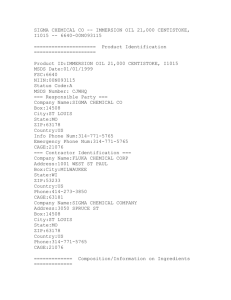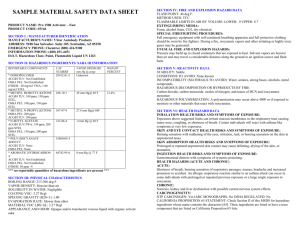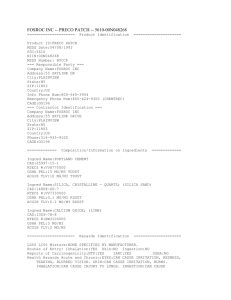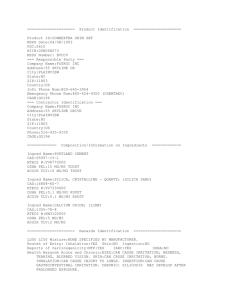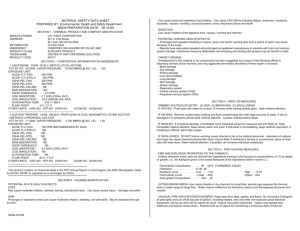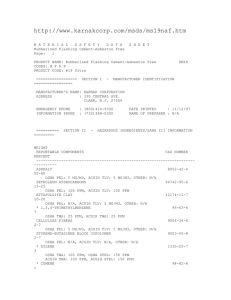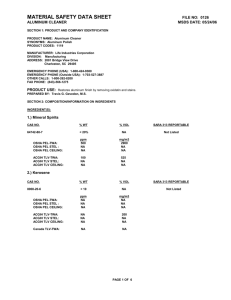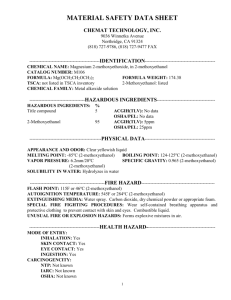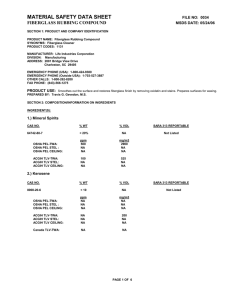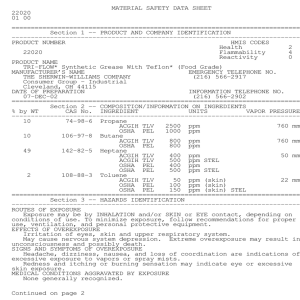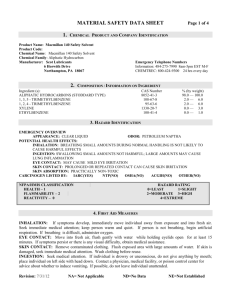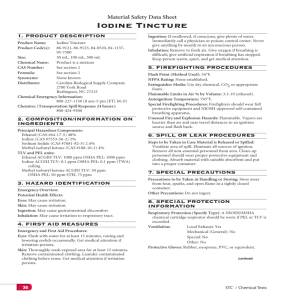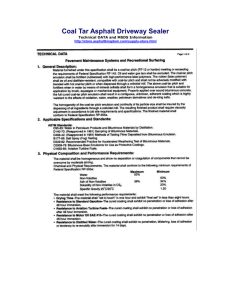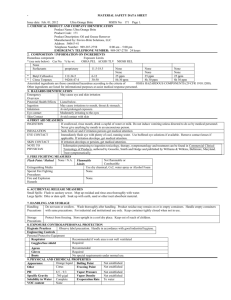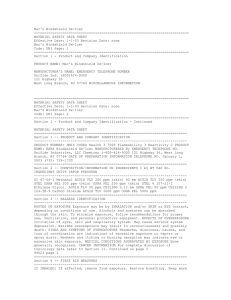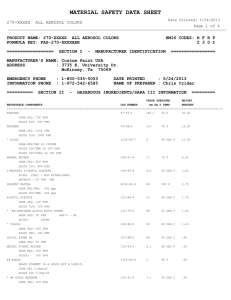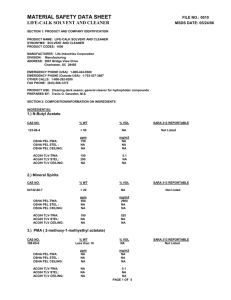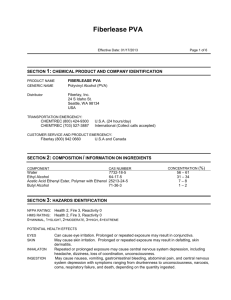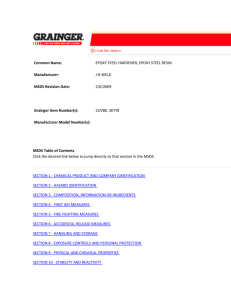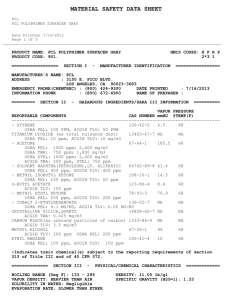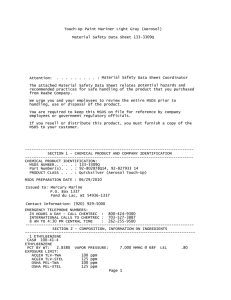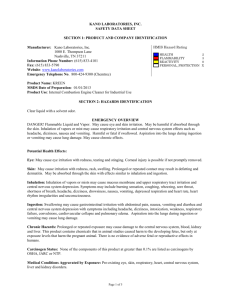M 9200 Spar Varnish - Air Tech Coatings Inc.
advertisement
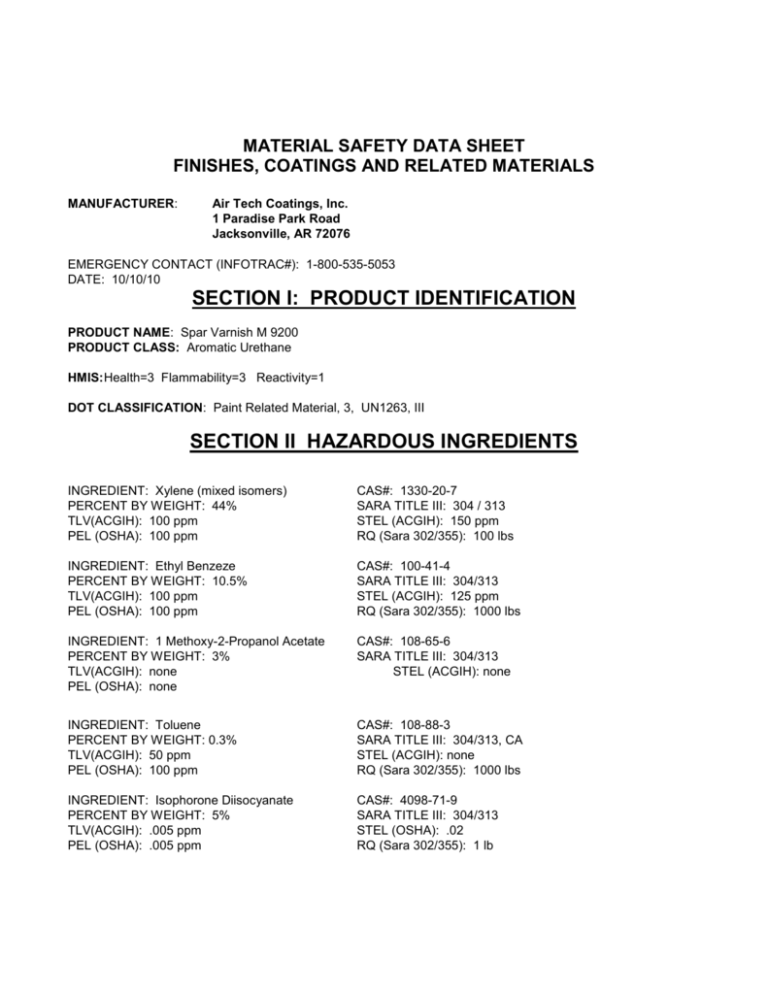
MATERIAL SAFETY DATA SHEET FINISHES, COATINGS AND RELATED MATERIALS MANUFACTURER: Air Tech Coatings, Inc. 1 Paradise Park Road Jacksonville, AR 72076 EMERGENCY CONTACT (INFOTRAC#): 1-800-535-5053 DATE: 10/10/10 SECTION I: PRODUCT IDENTIFICATION PRODUCT NAME: Spar Varnish M 9200 PRODUCT CLASS: Aromatic Urethane HMIS: Health=3 Flammability=3 Reactivity=1 DOT CLASSIFICATION: Paint Related Material, 3, UN1263, III SECTION II HAZARDOUS INGREDIENTS INGREDIENT: Xylene (mixed isomers) PERCENT BY WEIGHT: 44% TLV(ACGIH): 100 ppm PEL (OSHA): 100 ppm CAS#: 1330-20-7 SARA TITLE III: 304 / 313 STEL (ACGIH): 150 ppm RQ (Sara 302/355): 100 lbs INGREDIENT: Ethyl Benzeze PERCENT BY WEIGHT: 10.5% TLV(ACGIH): 100 ppm PEL (OSHA): 100 ppm CAS#: 100-41-4 SARA TITLE III: 304/313 STEL (ACGIH): 125 ppm RQ (Sara 302/355): 1000 lbs INGREDIENT: 1 Methoxy-2-Propanol Acetate PERCENT BY WEIGHT: 3% TLV(ACGIH): none PEL (OSHA): none CAS#: 108-65-6 SARA TITLE III: 304/313 STEL (ACGIH): none INGREDIENT: Toluene PERCENT BY WEIGHT: 0.3% TLV(ACGIH): 50 ppm PEL (OSHA): 100 ppm CAS#: 108-88-3 SARA TITLE III: 304/313, CA STEL (ACGIH): none RQ (Sara 302/355): 1000 lbs INGREDIENT: Isophorone Diisocyanate PERCENT BY WEIGHT: 5% TLV(ACGIH): .005 ppm PEL (OSHA): .005 ppm CAS#: 4098-71-9 SARA TITLE III: 304/313 STEL (OSHA): .02 RQ (Sara 302/355): 1 lb SECTION III: PHYSICAL DATA BOILING POINT: 275-302 °F PERCENT VOLATILE BY WEIGHT: 60 % SPECIFIC GRAVITY: 0.97 VOLATILE ORGANIC CONTENT (VOC): 582 GRAMS/LITER APPEARANCE AND ODOR: Clear Liquid SOLUBILITY IN WATER: essentially nil EVAPORATION RATE (N-BUTYL ACETATE = 1): slower than n-butyl acetate VAPOR PRESSURE (MM HG @ 68*F): ND SECTION IV FIRE AND EXPLOSION HAZARD DATA FLASH POINT: 79°F FLAMMABILITY CLASS: Flammable (1C) LEL: 1.0 EXTINQUISHING MEDIA: Use foam, carbon dioxide, or chemical fire fighting apparatus. Spill debris containing this product is subject to federal hazardous waste disposal regulations as a flammable (D001) hazardous waste and may be subject to incident reporting requirements. Additionally this product contains constituents that are subject to both SARA and RCRA regulations. Disposal must be done in compliance with federal, state and local requirements. SPECIAL FIRE FIGHTING PROCEDURES: Keep containers tightly closed. Isolate from heat, electrical equipment, sparks and open flame. Closed containers may explode when exposed to extreme heat. UNUSUAL FIRE AND EXPLOSION HAZARDS: The use of self-contained breathing apparatus is recommended for fire fighters. Water spray may be used for cooling containers to prevent possible pressure build-up and autoignition or explosion when exposed to extreme heat. Avoid spreading burning liquid with water used for cooling. This product reacts mildly with water releasing CO2 and some heat. Reaction is not violent. This material may form toxic isocyanate vapors if heated. FIRE PREVENTION: Extremely Flammable! Keep away from heat, sparks, flame and all other sources of ignition. Vapors may cause flash fire or ignite explosively. Do Not Smoke. Extinguish all flames and pilot-lights, turn off stoves, furnaces, hot water heaters, electric motors and all other sources of ignition during use or when containers are open until all vapors are gone. Beware of static electricity. Do not allow vapors to accumulate and concentrate in basements or enclosed areas. Use with adequate ventilation to prevent vapor buildup. Open all windows and doors. Use with cross ventilation of moving fresh air across work area. SECTION V: HEALTH HAZARD DATA THRESHOLD LIMIT VALUE: See Section II EFFECTS OF OVEREXPOSURE: OVERVIEW: Signs or symptoms of overexposure to this product may include headache, mild narcotic effects, fatigue, lassitude, loss of coordination, loss of consciousness, irritability, flatulence, gastrointestinal distress, nausea or vomiting, watery eyes or tearing, burning sensation in the eyes, severe irritation of the eye, dermatitis or skin rashes, asthmatic symptoms, chest tightness, severe respiratory irritation, anorexia and irritation of mucous membranes. EYE CONTACT: Severe irritation, redness, tearing, and blurred vision. SKIN CONTACT: Components of this product may be irritating to the skin. Components of this product can be absorbed through intact skin. Prolonged or repeated exposure may lead to an employee becoming sensitized to this product and chemically related products. INHALATION: Excessive inhalation of vapors can cause nasal and respiratory irritation, dizziness, weakness, fatigue, nausea, and headache. High concentrations may result in narcosis. This product is a potential respiratory and skin sensitizer. INGESTION: Can cause gastrointestinal irritation, nausea, vomiting and diarrhea. Aspiration of material into lungs can cause chemical pneumonia, which can be fatal. CHRONIC OVEREXPOSURE: Chronic exposure may cause damage to the Central Nervous System, Respiratory System, Lungs, Eyes, Skin, Gastrointestinal Tract, Liver, Spleen and Kidneys. Birth defect hazard: Contains a component that can cause birth defects of affect the fetus during pregnancy. Affects the blood and/or bone marrow causing either aplastic anemia, leukopenia or other blood abnormalities. MEDICAL CONDITIONS AGGRAVATED: Heart conditions, particularly those with abnormal heart rhythms. Respiratory conditions in particular asthmatic conditions and allergies. May affect those persons having low white cell counts and / or suffering from anemia. Skin conditions such as dermatitis and acne. Respiratory and Skin sensitizer! Persons sensitized to components of this product may react to exposure levels well below the established TLV. Effects of exposure may also not show until several hours after exposure. EMERGENCY AND FIRST AID PROCEDURES PRIMARY ROUTE (S) OF ENTRY: Inhalation and skin contact. EYE CONTACT: Flush with clean, lukewarm water for at least 15 minutes, occasionally lifting eyelids. Obtain medical attention. SKIN CONTACT: Remove contaminated clothing. Wash affected skin areas thoroughly with soap and water. Dispose of contaminated clothing. Once thoroughly washed, seek medical attention immediately. Components can be absorbed through intact skin resulting in toxic effects. INHALATION: Remove victim to fresh air. Apply artificial respiration or administer oxygen, if necessary. Seek medical attention immediately. INGESTION: Although not typically an industrial route of exposure, this product is poisonous and immediate medical attention is necessary. Contact the nearest poison control center and follow the directions they provide. This product does not contain 0.1% or more of any substance listed as a carcinogen by NTP, IARC, or OSHA. SECTION VI: REACTIVITY DATA STABILITY: Stable. This product reacts mildly with water releasing CO2 and some heat. Reaction is not violent. INCOMPATIBILITY: Avoid contact with strong oxidizing agents. Avoid storing near or combining with strong caustics, strong oxidizers, water, alcohol, ammonia, amines and direct flame. Reaction decomposition products include nitrogen oxides, carbon dioxide and monoxide, irritating vapors and water. Hydrogen cyanide can be generated in high temperature - low oxygen situations. HAZARDOUS DECOMPOSITION PRODUCTS: Thermal decomposition may yield carbon dioxide and/or carbon monoxide. HAZARDOUS POLYMERIZATION: Will not occur. SECTION VII: SPILL OR LEAK PROCEDURES STEPS TO BE TAKEN IN CASE MATERIAL IS RELEASED OR SPILLED: Evacuate all non-essential personnel. Remove all sources of ignition. Ventilate the area. Equip employees with appropriate protection equipment (see Section VIII). Dike around spilled material. Cover spill with inert absorbent material and shovel with non-sparking tools into container. Remove containers to safe area and seal. WASTE DISPOSAL METHOD: Waste material must be disposed of in accordance with Federal, State, and Local environmental regulatory controls. SECTION VIII: SPECIAL PROTECTION INFORMATION RESPIRATORY PROTECTION: If engineering controls do not maintain airborne concentrations below recommended exposure limits, an approved respirator must be worn. Respirator type: organic vapor. If respirators are used, a program should be instituted to assure compliance with OSHA Standard 29 CFR 1910.134. VENTILATION: Local exhaust must be sufficient to keep airborne vapor concentrations below the TLV limit. Exhaust air may need to be cleaned by scrubbers or filters to reduce environmental contamination. PROTECTIVE GLOVES: Chemical resistant gloves. EYE PROTECTION: Safety glasses with side shields. OTHER PROTECTIVE EQUIPMENT: Eye bath and safety shower. To prevent repeated or prolonged skin contact, wear impervious clothing and boots. SECTION IX: SPECIAL PRECAUTIONS PRECAUTIONS TO BE TAKEN IN HANDLING AND STORING: DRUMS: Protect against physical damage. Outside or detached storage preferred. BULK: Storage should be in standard flammable liquid storage tanks. OTHER PRECAUTIONS: All equipment should be grounded and bonded to reduce static electricity hazard. Use non-sparing tools. OTHER COMMENTS We recommend containers be either professionally reconditioned for reuse by certified firms or properly disposed of by certified firms to help reduce the possibility of an accident. Disposal of containers should be in accordance with applicable Federal, State, and Local laws and regulations. Empty drums should not be given to individuals. The information in this MSDS was obtained from sources, which we believe are reliable. However, the information is provided without any representation or warranty, expressed or implied, regarding it's accuracy or correctness. The conditions of handling, storage, use and disposal of the product are beyond our control and may be beyond our knowledge. For this and other reasons, we do not assume responsibility and expressly disclaim liability for loss, damage or expense arising out of or in any way connected with the handling, storage, use or disposal of the product.
